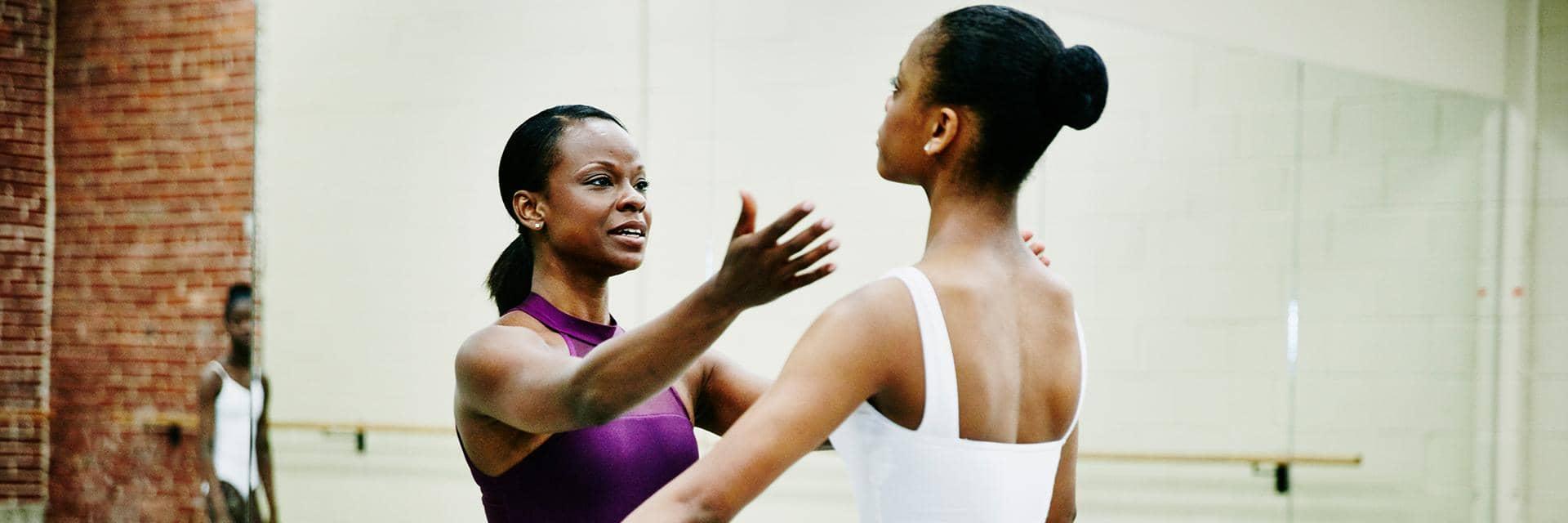
Responding to Ukraine: Philanthropy during a crisis
Find out how to speed up and improve the impact of your donations, so that your philanthropy makes a positive difference at pace for Ukraine.

24 February 2023
Amid a cost-of-living crisis, arts organisations are increasingly searching for new sources of funding – not only to showcase their artists’ work but also to enrich the lives of the people in the communities in which they exist.
As part of our series on philanthropy and the arts, we are exploring the role donors can play in helping creative bodies achieve their goals for social engagement.
Isabelle Hayhoe, our Senior Philanthropy Adviser, spoke to Sadler’s Wells Artistic Director and Chief Executive Sir Alistair Spalding, and Executive Director Britannia Morton, about the relationship between the arts and economic regeneration.
Isabelle Hayhoe (IH): Thank you for talking to us today. I’d like to start, if I may, by asking what most inspires you about your work in the arts?
Sir Alistair Spalding (AS): One of the things that happens every night at Sadler’s Wells, or most nights, is that we have a show. I get great satisfaction from the idea of people coming together for a collective experience after so much isolation. In some ways, it’s like putting on a party every night.
Britannia Morton (BM): Personally, I like to think of Sadler’s Wells as being at the centre of the whole ecology of dance. If you consider all the dance companies that come to us from around the world, we touch an awful lot of artists in a mutually supportive environment.
IH: Sir Alistair, you mention the isolation of the pandemic, and now unfortunately we have the cost-of- living crisis. Could you tell us a little more about how these events have shaped the priorities of Sadler’s Wells?
AS: I guess the main challenge has been that a number of things have hit us at the same time. There were other storms post-pandemic, such as the energy crisis and some audience members having a slight reluctance to return to the theatre.
Now, there’s the cost-of-living crisis, which meant increased utility costs and inflation. One of the main priorities has consistently been to keep our artistic projects going in this environment.
BM: To add to that, we also need to look after our colleagues as they struggle with the cost-of-living crisis. We also have to consider the impact of transport disruption, which really inhibits people from booking tickets, and can affect our staff’s ability to get home.
IH: It’s wonderful to hear of an organisation being so aware of the challenges its colleagues are facing. Broadening this out, how can creative bodies have a positive impact on their communities as a whole?
AS: There are two points to consider. The first is the positivity people feel when they watch creative performances. I think a lot of people connect with dance, in particular. We all have bodies and share the same physicality, but obviously the bodies on stage are a lot fitter than most of ours!
The second point is our work in community settings and schools. When young people partake in dance, all their other academic activities also tend to improve. It’s a tremendously healthy and positive experience.
IH: I’d love to hear more about your work with communities.
BM: As Alistair said, Sadler’s Wells has a lot of involvement with primary and secondary schools. We build bespoke relationships with each school by talking to teachers about how they would like us to support them and devising a personalised programme.
Another of our flagship projects is the National Youth Dance Company, which is a nationwide company for 15- to 19-year-olds. It’s an incredible gateway to a future artistic life.
And we also have our Company of Elders, which focuses on dance for the over 60s. The group is well-known as an exemplar of how to work with older people and has toured internationally.
IH: Moving on, this brings us to the topic of Sadler’s Wells East, the new premises in Stratford, which will be part of the Queen Elizabeth Olympic Park opening in 2024. This is one of the most economically deprived areas of London. What role can culture play in promoting regeneration?
BM: The Olympic legacy is very much focused on regenerating this part of London, and we feel a responsibility to make sure our work is relevant and supports local people. For example, we are committed to 50% of new jobs going to local people.
We also want to make sure that everyone feels they can come to this new, exciting building. It’s their place to do their thing. As part of this, we’ve built a stage in the foyer, which will be a shared resource for local dance groups. We’ll also be opening a hip-hop academy for 16- to 19-year-olds.
IH: It would also be interesting to hear about your efforts to become more environmentally friendly. I understand this is a key part of the design of Sadler’s Wells East.
BM: Sustainability is a core value for us. The new site will achieve a BREEAM excellent rating (a measure of a premise’s sustainability features). We’ll be incorporating natural ventilation, brown roofs, green roofs and rainwater harvesting into the building.
We’re also addressing our sustainable values through our artistic programme, and have several productions coming up that touch on the climate emergency as a theme.
IH: In these difficult times, fundraising is obviously a challenge for arts organisations. Can you tell us a little more about your efforts in this regard?
AS: Because what we do is quite costly, we rely on various sources of funding. Ticket sales make up around 70% of our income. We also receive a grant from Arts Council England, as well as the wonderful support of corporate sponsors and individuals.
IH: And why do you think donors find the arts an appealing sector to give back to?
AS: Many people are passionate about dance and want to give back to the art form they love. As donors, they often have a chance to come and share our joy, both on and off stage.
There is sometimes a tendency to see the arts as being ‘a nice-to-have’ or ‘the icing on the cake’. But, the pandemic proved that people miss this side of life when it’s no longer available. So, when donors find themselves in a position to be able to give back, they often support organisations such as ours and we are very grateful for their support.
IH: And one final question, if I may, what are your hopes for Sadler’s Wells in the future?
AS: We saw some green shoots with audiences returning in higher numbers at the end of last year, and we’re hoping this continues. I’ve been through a few recessions, and it’s amazing how people still want to come to the theatre. I also hope that we can continue to do great work and am very excited by our upcoming programme.
BM: For me, it’s about connecting great artists from around the world. When audiences come to Sadler’s Wells, they’re not just supporting us but the whole of dance.
Sir Alistair Spalding CBE, Artistic Director and Chief Executive of the world-leading dance organisation, Sadler’s Wells was awarded a knighthood for services to dance in the 2022 New Year Honours.
He has been the Artistic Director and Chief Executive of Sadler’s Wells Theatre since 2004 and is currently overseeing the construction of a fourth venue, Sadler’s Wells East, which will open in 2023. Under his leadership, Sadler’s Wells has become one of the most respected dance institutions in the world, presenting an ambitious programme of cutting-edge dance in all its forms and hosting world-class national and international companies and artists.
Britannia Morton is Executive Director for Sadler’s Wells and works with Sir Alistair Spalding CBE, Artistic Director and Chief Executive, and the board to define and deliver a long-term strategy for growth. She also leads on the planning and development of Sadler’s Wells East, the new venue in the Queen Elizabeth Olympic Park, which is due to open in 2023.
She has worked at Sadler’s Wells since 2010 and previously led operational teams at Southbank Centre, the Barbican, Royal Albert Hall and ENO.
Find out how to speed up and improve the impact of your donations, so that your philanthropy makes a positive difference at pace for Ukraine.
Isabelle Hayhoe speaks to Sir Alistair Spalding, and Britannia Morton, about the dance company’s artistic and fundraising ambitions.
We spoke to the Donmar Warehouse about the role of philanthropy in the arts, and their work to empower young people.
This communication is general in nature and provided for information/educational purposes only. It does not take into account any specific investment objectives, the financial situation or particular needs of any particular person. It not intended for distribution, publication, or use in any jurisdiction where such distribution, publication, or use would be unlawful, nor is it aimed at any person or entity to whom it would be unlawful for them to access.
This communication has been prepared by Barclays Private Bank (Barclays) and references to Barclays includes any entity within the Barclays group of companies.
This communication:
Any past or simulated past performance including back-testing, modelling or scenario analysis, or future projections contained in this communication is no indication as to future performance. No representation is made as to the accuracy of the assumptions made in this communication, or completeness of, any modelling, scenario analysis or back-testing. The value of any investment may also fluctuate as a result of market changes.
Where information in this communication has been obtained from third party sources, we believe those sources to be reliable but we do not guarantee the information’s accuracy and you should note that it may be incomplete or condensed.
Neither Barclays nor any of its directors, officers, employees, representatives or agents, accepts any liability whatsoever for any direct, indirect or consequential losses (in contract, tort or otherwise) arising from the use of this communication or its contents or reliance on the information contained herein, except to the extent this would be prohibited by law or regulation.



